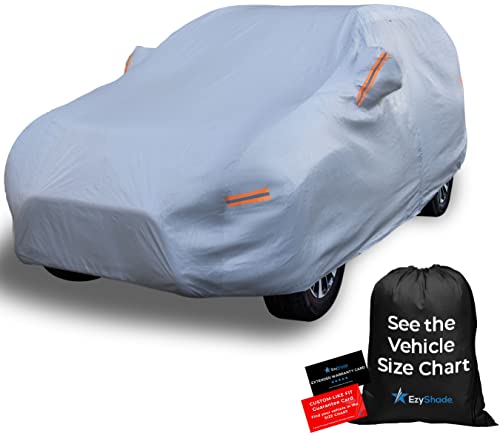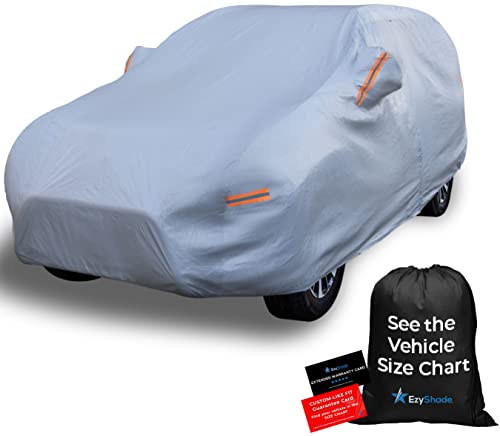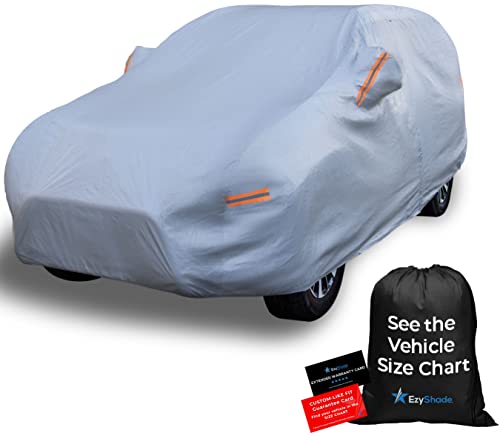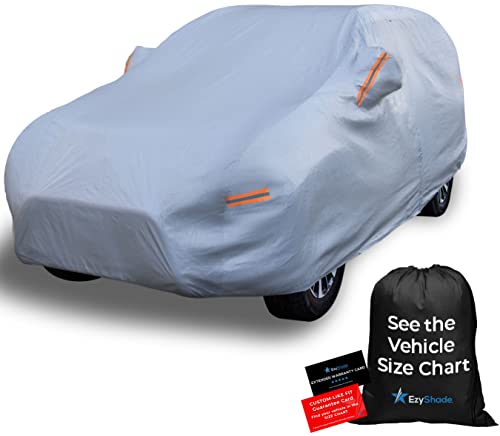Remember that stressful family road trip last summer? Cramped seats, questionable air conditioning, and a constant battle over the radio? This year, let’s avoid that chaos. This guide will help you find the best SUVs of 2025, ensuring comfort, safety, and reliability for your family adventures. We’ll cover everything from fuel efficiency to advanced tech, helping you make the perfect choice. By the end, you’ll be confident in your decision and ready to hit the open road.
Key Takeaways
- Discover the top-rated SUVs for 2025.
- Compare features, performance, and pricing across various models.
- Learn about the latest safety and technological advancements in SUVs.
- Understand factors to consider when choosing the best SUV for your needs.
- Find expert recommendations for different lifestyles and budgets.
Choosing the Right SUV for Your Needs
This section explores the diverse range of SUVs available in 2025, highlighting key factors to consider based on individual needs and preferences. We’ll delve into different sizes, functionalities, and price points, helping you narrow down your options effectively. Choosing the right SUV involves more than just aesthetics; it’s about aligning the vehicle’s capabilities with your lifestyle and budget.
Size and Passenger Capacity
SUVs come in various sizes, from compact to full-size, catering to diverse needs. Compact SUVs like the Honda HR-V offer fuel efficiency and maneuverability, while larger models like the Chevrolet Suburban prioritize spaciousness and passenger capacity. Consider the number of passengers you regularly transport and the amount of cargo space you require.
- Compact SUVs: Ideal for city driving and smaller families, offering excellent fuel economy.
- Mid-size SUVs: Balance practicality and comfort, suitable for families and frequent travelers.
- Full-size SUVs: Provide ample space for large families and extensive cargo needs, but with lower fuel efficiency.
Fuel Efficiency and Engine Performance
Fuel efficiency remains a critical consideration, especially given fluctuating fuel prices. The advancements in hybrid and electric SUV technology have significantly improved fuel economy, providing eco-conscious options. This section will analyze fuel efficiency ratings for various models and explore the performance characteristics of different engine types.
- Hybrid SUVs: Combine gasoline and electric power for better fuel efficiency and reduced emissions.
- Electric SUVs: Offer zero tailpipe emissions and potentially lower running costs, but have limited range.
- Gasoline SUVs: Provide traditional performance but with variable fuel efficiency depending on engine size and driving style.
The Best SUVs of 2025: A Comparative Analysis
This section presents a comparative analysis of some of the top-rated SUVs of 2025 across various categories. We’ll consider factors like safety ratings, technological features, performance metrics, and consumer reviews to provide a comprehensive overview. This comparison will aid in informed decision-making by highlighting the strengths and weaknesses of each model.
| SUV Model | Engine Type | Fuel Efficiency (mpg) | Safety Rating | Starting Price |
|---|---|---|---|---|
| Toyota RAV4 Hybrid | Hybrid | 39-41 | 5 stars | $28,000 |
| Ford Explorer | Gasoline | 20-26 | 4 stars | $36,000 |
| Subaru Outback | Gasoline | 26-33 | 5 stars | $27,000 |
| Kia Telluride | Gasoline | 20-23 | 5 stars | $34,000 |
| Tesla Model Y | Electric | 130 MPGe | 5 stars | $48,000 |
Note: These are estimated figures and can vary based on trim level and driving conditions. A 2025 consumer report suggests that hybrid SUVs are gaining significant market share due to increasing fuel costs.
Safety Features and Technology
Modern SUVs are equipped with advanced safety features and driver-assistance technologies. This section examines the available safety features in various models, including features like lane departure warnings, automatic emergency braking, and adaptive cruise control. We will also analyze the integration of infotainment systems and connectivity options.
- Advanced Driver-Assistance Systems (ADAS): Features like adaptive cruise control and lane-keeping assist enhance safety and driving experience.
- Safety Ratings: Check independent safety ratings from organizations like the IIHS and NHTSA to gauge the safety of different SUV models.
- Infotainment Systems: Evaluate the quality of the infotainment system, including its user interface, connectivity options, and available apps.
Understanding Advanced SUV Technologies
This section will delve into the specifics of advanced technologies found in many modern SUVs. We will explain complex features in a clear and concise manner, demystifying terms like “adaptive cruise control” and “lane-keeping assist.” Understanding these technologies is crucial for making an informed decision when purchasing a new SUV.
Adaptive Cruise Control (ACC)
Adaptive cruise control (ACC) is an advanced driver-assistance system that goes beyond traditional cruise control. Instead of maintaining a constant speed, ACC uses sensors to monitor the distance to the vehicle ahead and automatically adjusts speed to maintain a safe following distance. If the vehicle in front slows down, ACC will slow your vehicle accordingly, and it will resume the set speed once the traffic clears. This helps reduce driver fatigue and enhances safety.
Lane Keeping Assist (LKA)
Lane Keeping Assist (LKA) is a safety feature that helps prevent unintentional lane departures. Using cameras or sensors, LKA monitors the vehicle’s position within its lane. If it detects that the vehicle is drifting out of its lane, LKA will provide gentle steering corrections or alerts to guide the driver back into the lane. This system is particularly helpful during long drives or when drivers are experiencing fatigue.
Blind Spot Monitoring (BSM)
Blind spot monitoring (BSM) uses sensors to detect vehicles in your blind spots—areas that cannot be seen in your mirrors. If a vehicle is detected in your blind spot while changing lanes, BSM typically provides visual and/or audible warnings to alert you. This feature greatly enhances safety by reducing the risk of accidents caused by blind spots.
Real-Life Case Studies: Choosing the Best SUV
This section presents real-life examples of individuals choosing SUVs that met their specific needs. We will analyze the factors that guided their decisions, illustrating the importance of considering individual priorities when selecting an SUV. Learning from others’ experiences can help you make a more informed choice.
- The Young Family: A young family of four chose a Honda CRV for its reliability, fuel efficiency, and ample cargo space for their growing needs. The spacious interior and available safety features were major deciding factors.
- The Adventurous Couple: An adventurous couple opted for a Subaru Outback for its all-wheel-drive system, ground clearance, and rugged design. The Outback’s capabilities allowed them to comfortably explore off-road trails and handle various weather conditions.
- The Urban Professional: An urban professional chose a compact SUV like a Mazda CX-30, prioritizing fuel efficiency, maneuverability, and advanced technological features for commuting and city driving.
Debunking Common Myths About SUVs
This section aims to clarify common misconceptions about SUVs, providing factual information to aid informed decision-making. We will address frequent myths related to safety, fuel economy, and maintenance costs.
- Myth 1: All SUVs are gas guzzlers. While some large gasoline-powered SUVs have low fuel economy, many hybrid and electric SUV options offer surprisingly high efficiency.
- Myth 2: SUVs are unsafe. Many modern SUVs have top safety ratings, equipped with advanced safety features and driver-assistance technologies.
- Myth 3: SUVs are expensive to maintain. Maintenance costs can vary widely depending on the model and your driving habits, but many manufacturers offer competitive service plans.
Final Thoughts
Choosing the best SUVs of 2025 is a personal journey guided by your unique needs and preferences. By considering factors like size, fuel efficiency, safety features, and technology, you can confidently select an SUV that aligns perfectly with your lifestyle. Remember to test drive different models, compare pricing, and thoroughly research before making your final decision. The open road awaits—choose wisely and enjoy the ride!
FAQ
What are the top three features to prioritize when buying an SUV in 2025?
Safety features (like automatic emergency braking and lane departure warnings) are crucial. Fuel efficiency (considering hybrid or electric options) is increasingly important due to rising fuel costs. And finally, cargo space and passenger comfort are vital for practicality and family needs.
How much does the average SUV cost in 2025?
The average price varies widely based on model, features, and trim level. Expect to find compact SUVs starting around $25,000, mid-size SUVs around $35,000, and full-size SUVs exceeding $45,000. Electric SUVs generally fall at the higher end of this range.
Are electric SUVs a good option in 2025?
Electric SUVs are becoming increasingly popular, offering zero tailpipe emissions and potentially lower running costs. However, factors like range, charging infrastructure, and initial purchase price need careful consideration before choosing an electric SUV.
What are the best SUVs for off-roading?
SUVs with all-wheel drive or four-wheel drive systems, high ground clearance, and robust construction are ideal for off-roading. Models like the Jeep Wrangler, Subaru Outback, and Toyota 4Runner are frequently cited as excellent choices for adventurous off-road excursions.
How do I compare the safety ratings of different SUVs?
Consult independent safety rating organizations like the Insurance Institute for Highway Safety (IIHS) and the National Highway Traffic Safety Administration (NHTSA). These organizations provide crash test ratings and safety feature assessments to help you compare the safety performance of various SUV models.
What are the best family SUVs of 2025?
The “best” family SUV depends on family size and needs, but popular choices include the Honda Pilot, Toyota Highlander, Kia Telluride, and Chevrolet Suburban. These models offer spacious interiors, multiple seating configurations, and ample cargo space for family essentials.
What is the difference between AWD and 4WD in SUVs?
AWD (all-wheel drive) constantly distributes power to all four wheels, improving traction in various conditions. 4WD (four-wheel drive) allows you to switch between 2WD and 4WD, typically offering more off-road capability but potentially reduced fuel efficiency in 4WD mode. AWD is generally better for everyday driving, while 4WD is preferable for off-road situations.






